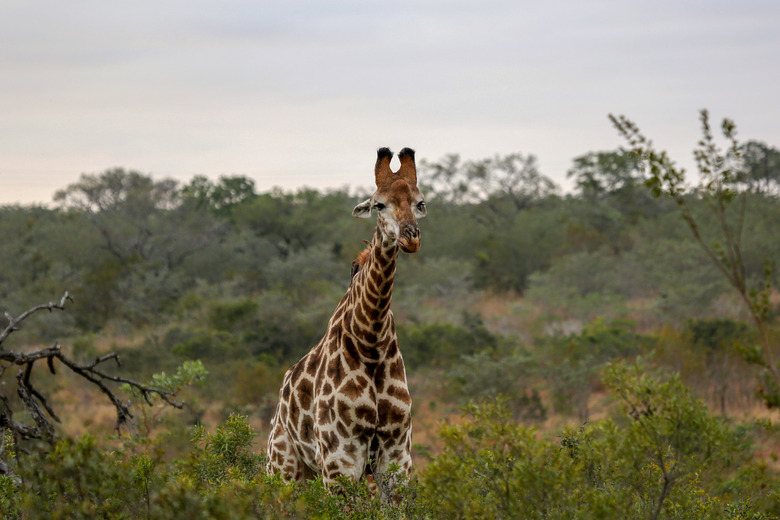Information On Giraffe Eyes
Giraffes are herbivores that live in the African savannahs. As the tallest mammals in the world, they reach a giant 14 to 19 feet (4.3 to 5.8 meters) as adults and weigh between 1,750 and 2,800 pounds (794 to 1,270 kilograms).
Their height helps them graze on the leaves of tall trees, like acacia, but makes it difficult for them to reach down to drink water. Giraffes' long legs enable them to run up to 35 miles (30.6 kilometers) per hour.
Mammal Eye Function
Light enters the eyeball through the clear cornea. The amount of light that enters the eye is controlled by the iris and pupil. Ciliary muscles contract or dilate the iris to allow more or less light into the pupil.
The lens then focuses the light onto the retina. The lens is also responsible for controlling the near and distant focus by adjusting its convexity.
The space between the lens and the retina is called the posterior chamber and is filled with a fluid called vitreous humour. The retina contains rods that are used mainly for low-light conditions and cones that distinguish colors, details and image sharpness.
Visual information from the retina is delivered to the brain via the optic nerve. The brain receives an upside-down image and then processes it to move it the right way up.
Eye Placement
Giraffes have their eyes located on each side of their head, bulging out slightly. The placement and bulging help give them a panoramic peripheral vision.
The more peripheral vision an animal has, the more of their world they can see without having to turn their heads, helping them to look for predators.
Giraffe Vision
Giraffes have very high visual acuity, which may help them as they live in wide open spaces. Their special arrangement of light-sensing cells allows them to simultaneously look at their feet and a few meters ahead while walking.
These cells also help them to see objects close to their face, which help them when foraging. Color vision allows giraffes to select ripe food and succulent leaves.
Eye Growth
When they are born, a giraffe eye's volume is about 2 cubic inches (33 cubic centimeters). As adults, their eye volume reaches around 4 cubic inches (65 cubic centimeters). As babies, their focal length is 1.6 inches (40 millimeters) while adults have a 1.9-inch (48-millimeter) focal length.
Their retina surface area also increases as they grow from 4.65 square inches (3,000 square millimeters) to 6.7 square inches (4,320 square millimeters) as adults.
Monocular vision is when each eye is used independently. Binocular vision is when both eyes are used in conjunction with each other.
When they are born, giraffes have monocular-type vision, giving them a wider field of view but poor depth perception. As adults, their vision becomes more binocular, meaning they have a smaller field of view but greater focus.
Giraffe vs. Camel Eyelashes
Eyelashes are hairs used to protect the eye from dust, sun and other debris that could damage the delicate eye. Eyelashes are also highly sensitive structures, like cat's whiskers, to help protect the eye from being hurt.
While both camels and giraffe eyelashes are thick and used to keep sand out, camels have an extra set of eyelashes for additional protection.
Read more about the the characteristics that helps giraffes survive.
Zebras Using Giraffe's Vision
Giraffes' immense height helps them to see long distances over the grasslands. When a predator is sighted, giraffes change their behavior and body posture.
Zebras have learned to identify these cues and react accordingly. When zebras herd with the giraffes in this way, they become more relaxed at looking out for predators themselves and rely on the giraffes to keep a lookout.
References
- Vision Eye Institute: The Eyelashes
- SPANA: 13 Fun Facts About Camels
- Giraffe Worlds: Giraffe Anatomy
- Brain, Behavior and Evolution: Visual Acuity in Mammals: Effects of Eye Size and Ecology
- Giraffe; Edgar Williams
- African Zoology: Orbit Orientation and Eye Morphometrics in Giraffes (Giraffa Camelopardalis)
- Scientific American: Exploring the Depths – of Vision!
- Canadian Association of Optometrists: Binocular Vision
- National Geographic: Giraffe
- Bright Focus Foundation: Anatomy of the Eye
- Behavioral Ecology: Zebra Reduce Predation Risk in Mixed-Species Herds by Eavesdropping on Cues From Giraffes
- Arizona State University: Rods and Cones of the Human Eye
- Encyclopaedia Britannica: Giraffe
Cite This Article
MLA
Jerrett, Adrianne. "Information On Giraffe Eyes" sciencing.com, https://www.sciencing.com/information-giraffe-eyes-8665464/. 22 November 2019.
APA
Jerrett, Adrianne. (2019, November 22). Information On Giraffe Eyes. sciencing.com. Retrieved from https://www.sciencing.com/information-giraffe-eyes-8665464/
Chicago
Jerrett, Adrianne. Information On Giraffe Eyes last modified March 24, 2022. https://www.sciencing.com/information-giraffe-eyes-8665464/
